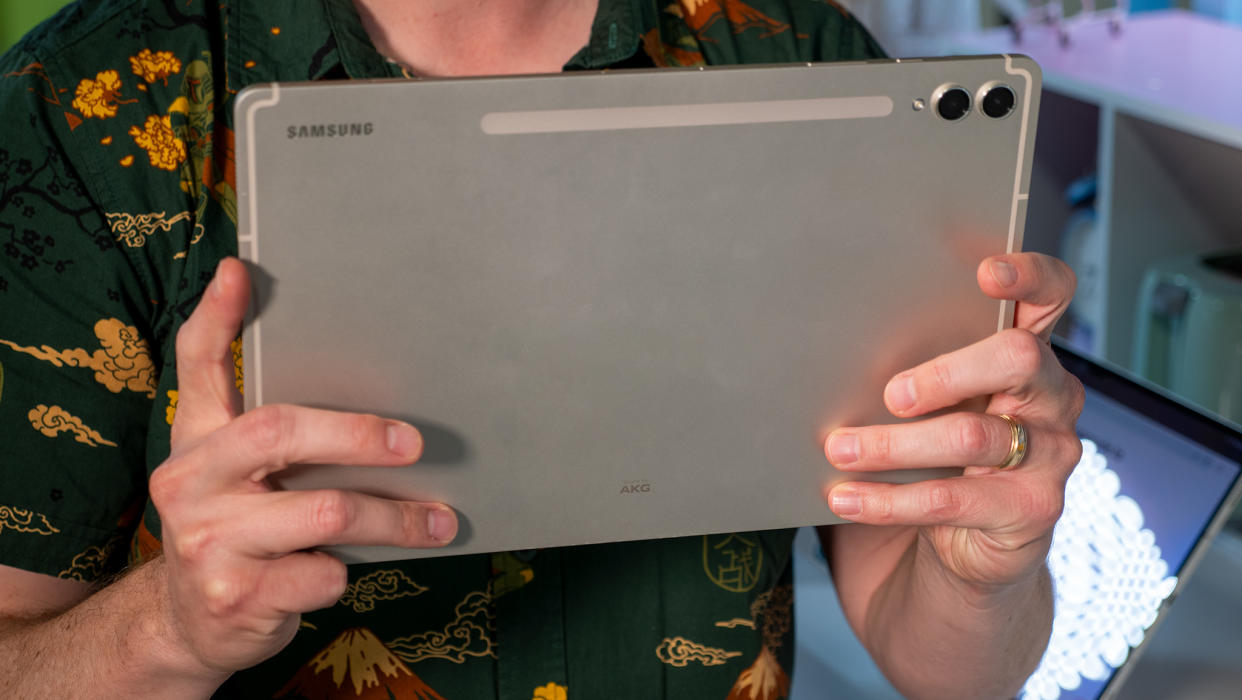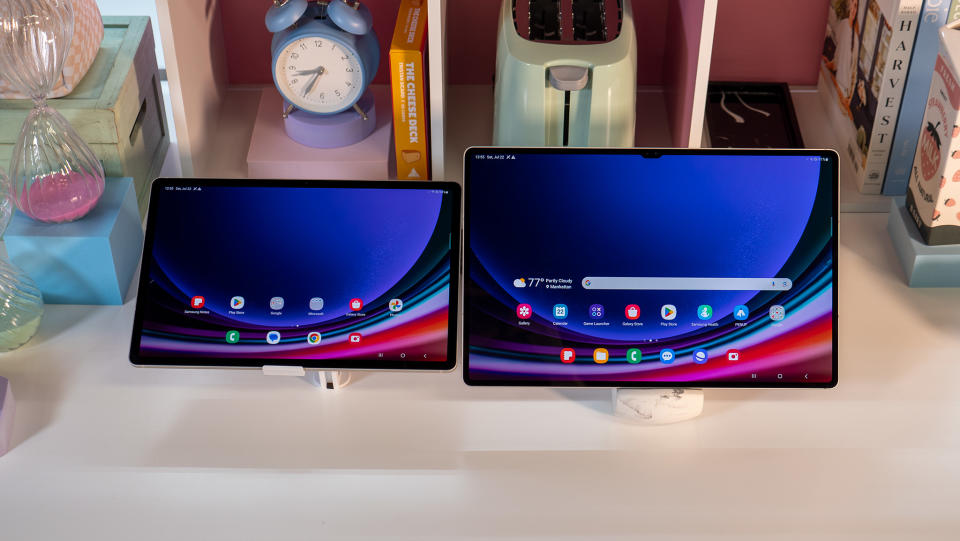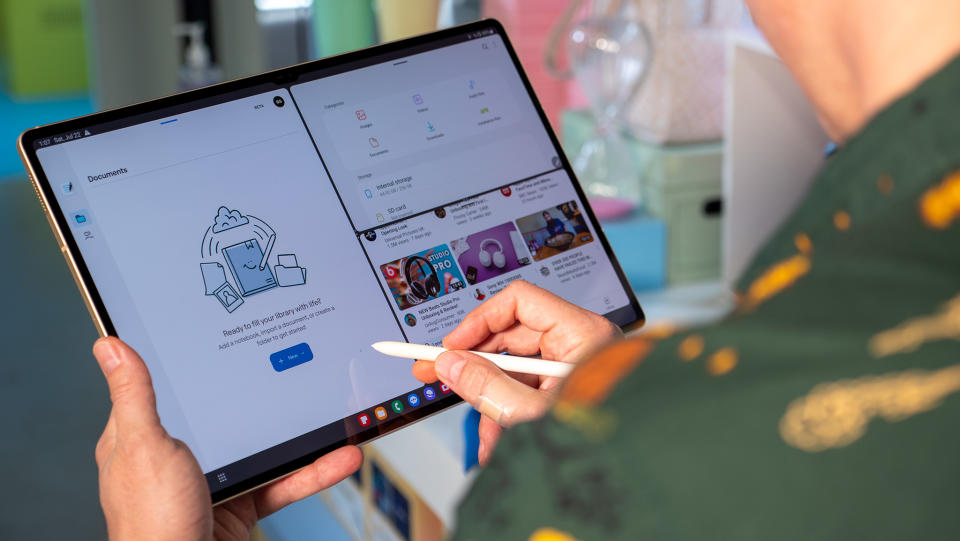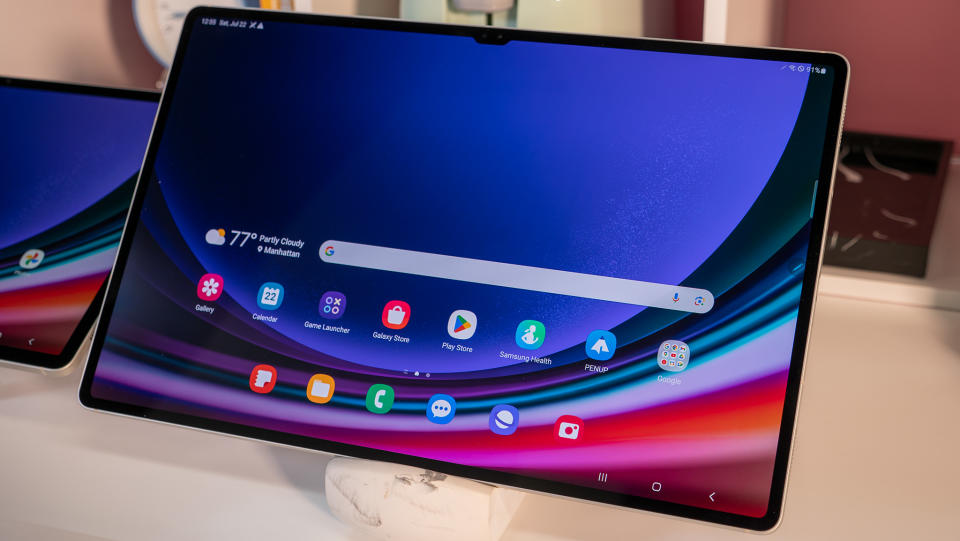Samsung Galaxy Tab S9 revealed: Specs, Tab S8 upgrades, and which to buy

Galaxy Unpacked gave us our first official glimpse of the Galaxy Tab S9, confirming what the leakers claimed: Samsung has made the first mainstream waterproof tablet. Add a case and screen protector, and you'll have a rugged tablet without the usual downsides with those devices.
Of course, this isn't the only new change the Galaxy Tab S9, Tab S9+, and Tab S9 Ultra bring to the table. Larger Dolby Atmos speakers, upgraded S Pen, blazing Snapdragon performance, and Vision Booster all give you a new experience compared to the Tab S8.
And in particular, the 11-inch Tab S9 gets the biggest upgrade: a switch from LCD to AMOLED display. You'll no longer feel pressured to upgrade to the larger Plus or Ultra for the best visual experience. Still, both of the upgraded models do have one or two perks over the base Tab S9.
You can check out our Galaxy Tab S9 hands-on for an in-depth look at how the tablets feel and perform. Otherwise, this Samsung Galaxy Tab S9 buying guide will run you through the release date, price, changes from the Tab S8, differences between the three Tab S9 models, and everything else you need to know.
Samsung Galaxy Tab S9 release date and models

Announced at the July 2023 Samsung Galaxy Unpacked event on July 26, the Galaxy Tab S9 is available for pre-order now, along with other Unpacked devices like the Galaxy Watch 6 or Galaxy Z Fold 5.
The Tab S9 officially ships on Friday, August 11, so August 10 is the last day to take advantage of any Tab S9 pre-order deals.
The Galaxy Tab S9 series' pricing is virtually unchanged from the Tab S8. The 11-inch Tab S9 starts at $800, with a $200 gap between it and the Tab S9+ ($1,000) and Tab S9 Ultra ($1,200). Unlike last year, however, both the Tab S9+ and Ultra start at 12GB of RAM instead of making you pay extra for it.
We're still confirming the price for storage and RAM upgrades, but we believe you'll pay $80 extra for more storage on the Tab S9 and S9+, while a RAM upgrade to 16GB for the Ultra could be up to $300 more if it matches the Tab S8 Ultra. We'll update here when we know more.
Tab S9, S9+, and S9 Ultra specs compared
All three Galaxy Tab S9 models share the same AMOLED 2X display quality and refresh rate, though the pixels per inch will naturally dip for the larger models. They have the same Snapdragon 8 Gen 2 for Galaxy chip found in the Galaxy S23 series, and share the same quad speaker set-up. They also share the same S Pen with 2.8ms of latency.
Upgrade from the Tab S9 to the Tab S9+, and you get more than a larger display. You add an 8MP ultra-wide rear camera, a larger battery (though this is offset by the 12.4-inch display), and an option to buy it with 5G for cellular connectivity on the go. The Tab S9+ also has twice the storage and 4GB extra RAM out of the box, and the Tab S9 has no 12GB RAM or 512GB storage options.
For the top-tier Galaxy Tab S9 Ultra, you start with the same 12GB/256GB memory as the S9+, but it's the only tablet with a 16GB/1TB variant if you can afford it. You also get a second 12MP selfie camera, in addition to the ultra-wide cam on all three tablets.
Generally speaking, there isn't that much different between the three Galaxy Tab S9 models. So far, all three have the same two color options (Graphite and Beige), and their thickness only varies by 0.2mm from one Tab to the next.
Samsung Galaxy Tab S9 vs. Tab S8

We'll write a more in-depth guide of the Galaxy Tab S9 vs. Tab S8 to compare every minute difference, but we'll also run through the highlights below:
Snapdragon 8 Gen 2 vs. Gen 1: The newest Qualcomm flagship chip has blown away the Snapdragon 8 Gen 1 chip found in the Tab S8, which had fast speeds but tended to overheat during heavy use. You can see our Snapdragon 8 Gen 2 vs. 1 guide to see how the two chips compare in general.
Benchmarks aren't a perfect metric, but our parent company's Future Labs team found the Tab S8 8GB hit 1208/3228 in Geekbench 5 single-core/multi-core benchmarks. Compare that to the 8GB Galaxy S23 scores: 1522/4876. Phones and tablets perform differently with the same tech, but we can still expect minor improvements for browsing and everyday apps; and for heavy-duty mobile gaming, you could see a 1.5X boost with the same memory, while also running more efficiently.
IP68 protection: Tablets almost never offer any official dust or water protection. But now, this IP rating means the Galaxy Tab S9 won't take on particles if you take it to the beach, or that you can submerge the tablet in water for a short time without damaging it.
Tab S9-specific upgrades: While the 11-inch Tab S8 had an LCD display, the Galaxy Tab S9 switches to AMOLED, matching its larger siblings. This gives you better, richer colors and the same 2.8ms S Pen latency. Plus, the battery size jumps from 8,000 to 8,400mAh, probably to accommodate AMOLED's power demands; the Tab S9+ and Ultra batteries remain the same as their S8 counterparts.
Vision Booster: Now that your Tab S9 can handle outdoor hazards, Samsung has added its Vision Booster tech found on its phones. In Samsung's words, it "uses an intelligent algorithm to automatically detect ambient light conditions and optimize screen settings which leads to enhancements in contrast, color and brightness."

More default RAM and storage: The Tab S9+ and Ultra start with 12GB/256GB, whereas the Tab S8+ and Ultra only sport 8GB / 128GB by default. We also think the Tab S9 series will have UFS 4.0 instead of 3.1 for any storage above 128GB, but are waiting for confirmation from Samsung. If true, you'll get twice as fast read/write speeds for stored data and improves performance for applications like game loading compared to the UFS 3.1 in older Tabs.
Cameras: You get a small resolution jump for the rear ultra-wide camera from 6MP to 8MP for the Tab S9+ and Ultra, while the Tab S9 loses that UW camera (something the Tab S8 has). Otherwise, the camera hardware and extra 12MP selfie cam for the Ultra are unchanged from the Tab S8 series.
S Pen: Like the new tablets, the bundled S Pen has an IP68 rating. Samsung also says the new stylus has "optimized" pressure sensitivity on the side button, and that it charges on the Tab S9's rear "whether you place it up or down," instead of having to place it a certain way.
Dimensions: The lengths, widths, and thickness of all three Tab S9 models fall within a millimeter of the Tab S8s, with only a few decimal points of difference between them. The only change worth noting is that the Tab S9 thickness dips from 6.3mm to 5.9mm.
As for their weights, the Tab S9 is 5g lighter, the Tab S9+ 14g heavier, and the Tab S9 Ultra 6g heavier.
Samsung Galaxy Tab S9: Which should you buy?

We had the opportunity to test out the Galaxy Tab S9 in New York City prior to the Unpacked unveiling, so you can see our first impressions of the tablet and see how all of these differences come across in real life. Plus, we intend to review the Galaxy Tab S9 soon and offer more in-depth thoughts.
For now, we can provide some basic thoughts on which Galaxy Tab S9 you should buy, based on our time with the Galaxy Tab S8+ and Tab S8 Ultra.
You should choose the Galaxy Tab S9 if you're used to a "standard" tablet size. Most tablets fall into the 10- to 11-inch range, and 1.1 pounds is also about average compared to most Android tablets. It's not quite enough display space for serious desk work or multitasking, but it's really the only comfortably portable model.
You have to accept being stuck at 8GB RAM, but as we already explained, the Snapdragon 8 Gen 2 is a performance beast that doesn't need extra memory except for really specific circumstances like hitting the highest graphics in Genshin Impact. Of course, if you do want a gaming tablet where you'll use a controller instead of your hands, you may opt for a larger size.
We loved the Galaxy Tab S8+ because it gave you a screen that's close to laptop-sized for productivity, but isn't so massive like the Ultra — meaning you can still hold it fairly comfortably on your stomach for streaming in bed. That same principle will apply to the Galaxy Tab S9+: large enough to take full advantage of its processing power, but not too large.
Plus, it's the only model with 5G; now that it has an IP68 rating and you may want to use it outdoors more often, that might prove useful to you.
As for the Galaxy Tab S9 Ultra, its upside is obvious: that massive display makes it useful as a laptop-replacing device that won't take up as much room in a backpack. Just keep in mind that you'll probably keep it on a desk most of the time, whether for work or play; so you'll need a keyboard accessory to get the most out of it. That could add several hundred dollars more on top of the already-high price.

Samsung Galaxy Tab S9: $800 at Samsung
With an IP68 rating, 120Hz OLED display, waterproof S Pen with just 2.9ms latency, the Snapdragon 8 Gen 2 for Galaxy
chip with top-tier performance, and extra battery capacity, the Galaxy Tab S9 is a significant step up compared to the Tab S8. And pre-ordering it nets you a free storage upgrade!View Deal

